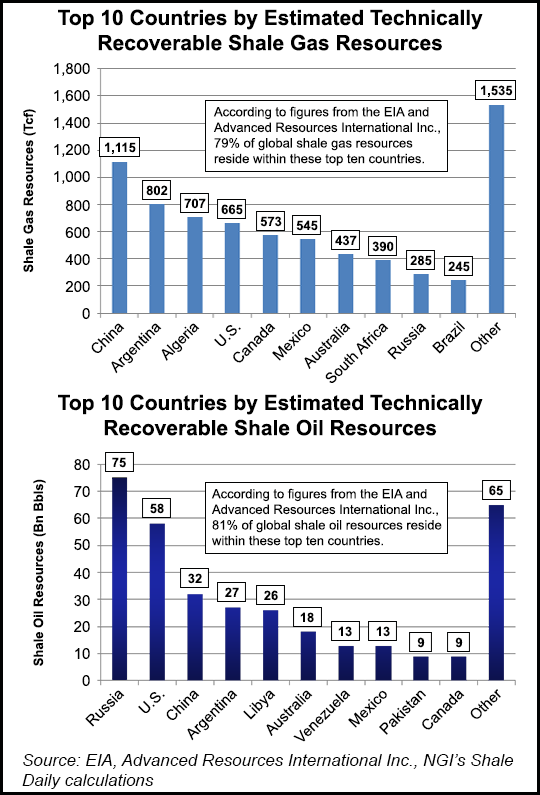NGI Archives | NGI All News Access
U.S. Onshore Plays Still Driving Global Gas Reserves, Eni Review Finds
Global oil reserves last year were 0.4% higher year/year, while natural gas reserves jumped 1.7%, thanks mainly to U.S. onshore plays and discoveries in East Africa, according to 13th edition of Eni SpA’s World Oil and Gas Review.

The Italian oil major annually presents an energy review based on research by an inhouse economics team. Unlike the Eni report, ExxonMobil Corp., BP plc, Royal Dutch Shell plc and Statoil ASA present global energy outlooks based on inhouse economic data.
Private analysts and prognosticators have touted the Golden Age of Gas. Eni’s team said the world’s gas reserves grew in 2013 (1.2% from 2012), more than double that of oil (0.5% versus 2012).
“In the year 2013, a slight growth in oil reserves was registered thanks to the contribution of the non-OPEC countries, with the United States leading the way (plus-9.8% compared with the previous year), followed by Norway (plus-8.6%),” the researchers said. “OPEC countries’ reserves remain substantially stable. The United States, in recent years, has become leader in the oil and gas production growth, at the same time consolidating its position as leading world consumer.”
The United States held its leadership position in crude oil production growth, with an increase of 12.2% from 2012 “by virtue of the contribution of tight oil.” That counterbalanced the drop in oil production by Iran (down 9.8%) and Libya (down 35.5%).
Global oil consumption increased more than gas in 2013, according to Eni. Oil consumption in 2013 was up by 1.4%, while natural gas consumption rose 1% from 2012. The highest gas demand was seen in the United States.
Last year was the first time since the 2008-2009 economic crisis that the developed countries recorded a “positive trend of oil demand,” even though the European “consumption crisis” remains, with oil demand down 7% from 2012. Among the undeveloped/emerging countries, “China’s continuous predominance place it as the second largest country in the world for consumption.”
Worldwide growth in gas consumption overall was “modest,” according to Eni’s economists, only about 1% higher year/year, compared with a 2.5% average per year between 2000 and 2013.
“The large availability of domestic gas production endorses the growth in consumption in the United States (plus-2% versus 2012) confirming to be the first world consumer of gas.”
Eni operates in the United States, mostly in the Gulf of Mexico (see Daily GPI, May 8; March 19). It also has bid for leases in Alaska’s Chukchi Sea (see Daily GPI, April 10). In 2013, Eni was tied for No. 16 with U.S.-based refiner Phillips 66 on the Fortune Global 500 list (see Daily GPI, July 9, 2013).
© 2024 Natural Gas Intelligence. All rights reserved.
ISSN © 2577-9877 | ISSN © 2158-8023 |
